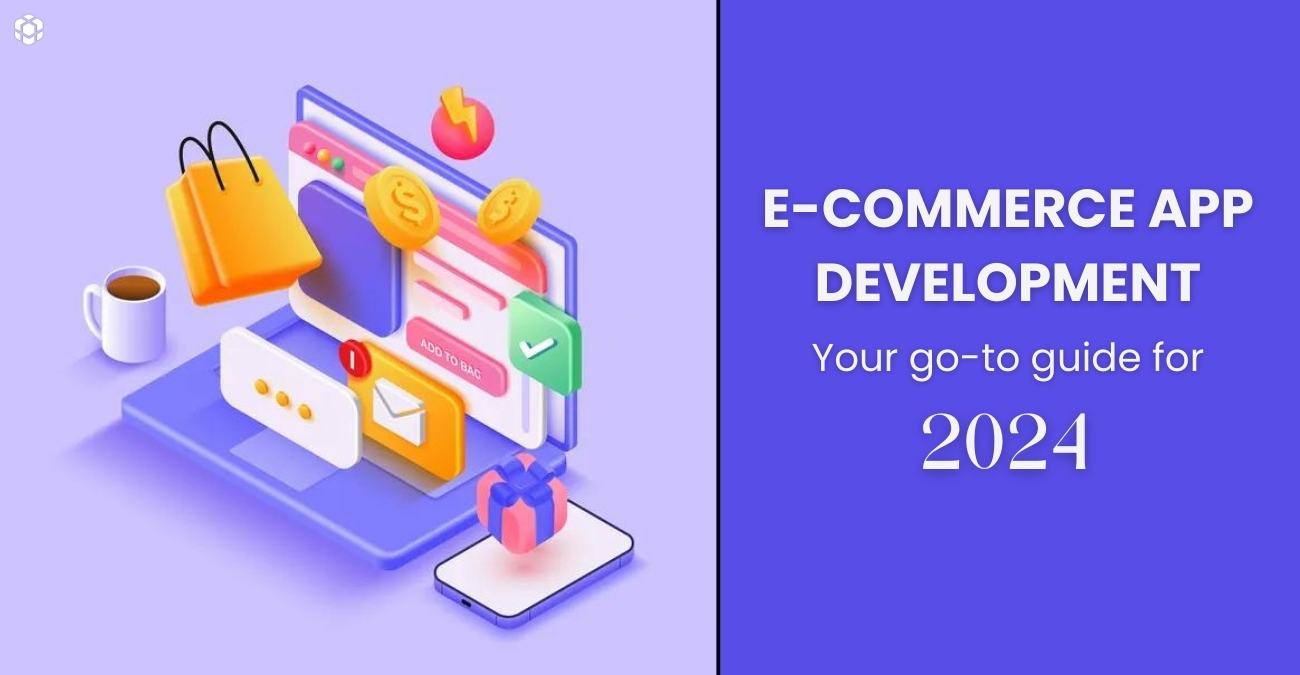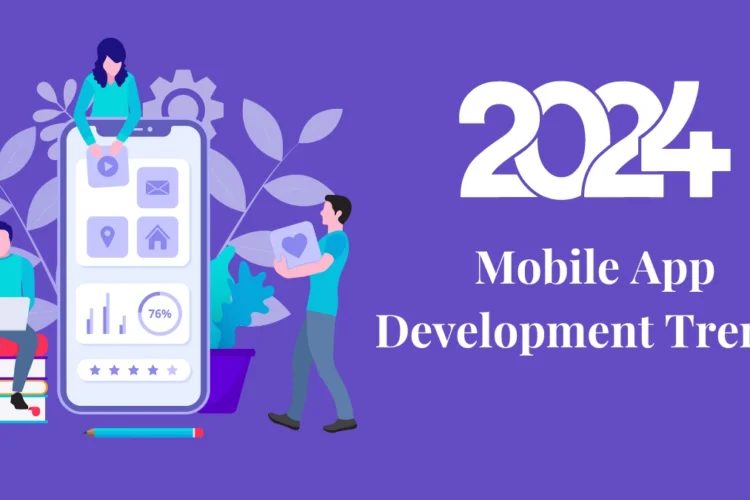
These days, the motivation behind developing e-commerce apps is quite significant, particularly given that mobile phones are rapidly consuming the whole technological industry. The commercial value offered by creating apps increased dramatically along with the rise in popularity of mobile phones, tablets, and laptops. With the e-commerce industry, the upsurge of mobile apps quickly grasped over the current generation.
The era of standing at checkout queues, fiddling with loyalty cards, and trying to figure out outdated coupon codes is considered a thing of the past. For companies of all shapes and sizes, an eCommerce solution development for mobile platforms offers the chance to draw in a sizable consumer base. Customers throughout the world today benefit from the advantages of online purchases because of the information technology, mainly through smartphone eCommerce applications that are accessible on the go.
The information in this guide is for you if you wish to implement an eCommerce solution for mobile customers into your business. In addition to covering other essential details about eCommerce mobile app development, we will define an eCommerce mobile app in this blog post. Let’s get started!
What is E-commerce Application Development?
E-commerce application development refers to the process of creating mobile apps specifically designed for online shopping experiences. These apps bridge the gap between your online store and the pockets (and fingertips) of your customers, allowing them to browse products, make purchases, and manage orders – all on the go.
App development for E-Commerce goes beyond just a mobile storefront. It encompasses features like personalized recommendations, one-click purchases, secure payment gateways, and push notifications – all working together to create a seamless and engaging shopping experience that keeps customers coming back for more.
A user-friendly and feature-rich e-commerce application is now a need rather than a luxury in today’s world of online purchasing. E-commerce applications promote returning customers and client loyalty by offering a convenient and customized buying experience.
A key advantage that e-commerce business owners frequently neglect is the ability to accomplish various business goals using multiple application types. Determining what kind of application is required before launching one can be a good first step towards achieving business objectives such as improved UX-UI, which increases conversion and improves user engagement.
Reasons to Create an E-Commerce App
When you can utilize the world at large as your place of business, why limit yourself to a simple traditional establishment? Getting involved with e-commerce applications is like putting an accelerator on your business goals in a world where smartphones are essentially an expansion of our mobility. You may wonder, “Why choose an e-commerce app?” Let’s discuss it now:
Easy access: Whether they are at home watching their favorite TV show, traveling, commuting to work, or even at a party, your consumers may shop whenever and wherever they choose. Your internet presence is guaranteed around the clock, thanks to your app’s e-commerce store.
Individuality: Do you recall the kind of store clerk who was familiar with your name and tastes? With customized shopping experiences and personalized recommendations, your app may recreate that magic and give your users a feeling of being really understood.
Valuable Data Insights: An abundance of useful data is available in an e-commerce software that lets you examine customer behavior, patterns, and interests. You may adjust your offers and marketing methods like a genuine digital genius by making sense of this invaluable data. This data can be used to personalize product recommendations, tailor marketing strategies, and ultimately optimize your overall sales funnel.
Economical Cost: E-commerce app development has many advantages over opening a physical business, like lower expenses, fewer operational costs, and the ability to grow without hiring a huge number of store employees.
Boost Brand Loyalty: A well-crafted app with features like loyalty programs and wishlists incentivizes repeat visits and purchases. By providing a personalized and rewarding experience, you can build a stronger customer base.
Increased Conversion Rates: Streamlined checkout processes and one-click purchase options within an app can significantly reduce cart abandonment and boost conversion rates.
Competitive Advantage: In a crowded online marketplace, a feature-rich app can set you apart from the competition. It demonstrates your commitment to providing a superior customer experience and positions you as a leader in mobile commerce.
E-commerce applications deliver indisputable advantages, such as constant accessibility and the ability to build brand loyalty through customization and insightful user data. Instead of settling for a conventional storefront, make use of e-commerce applications to put your company’s full potential in the hands of your clients.
Essential Elements of E-commerce Apps
Creating an e-commerce application that consumers can use at any time and from almost any place is an essential tool for every modern business to run smoothly. Since most retail transactions take place online and on mobile devices, an app can significantly improve the sequence of events that controls startup and large-scale corporate transactions.
You need the best web development company to construct an e-commerce app. It’s imperative to incorporate essential features that improve user experience and increase conversions with the support of this app. Following are some key features of e-commerce apps to think about:
Verification of Users
Facilitating individuals to register with their social network credentials. Establishing safe authentication procedures in place to safeguard user data.
Reviews and Feedback
Give consumers the option to rate and evaluate the goods they have bought. Among prospective customers, this gesture promotes credibility and confidence.
Social Media
Include social media sharing buttons so that customers may tell their friends and followers about the products and services they love. Make use of social media platforms to increase brand awareness and encourage user interaction.
Product Search and Catalog
Creating an extensive product catalog with sections that are useful with crisp product descriptions, and excellent photographs. Setting up a powerful search functionality to help customers locate any product immediately.
Cart in and Check out
Enabling customers to quickly add items to their shopping carts, check the status of their orders, and easily go through a safe checkout process. Providing a number of payment choices to guarantee a simple and easy transaction environment.
Payment Structure
Incorporating well-known payment gateways to enable safe and practical transactions. To protect sensitive user data, e-commerce businesses utilize encryption and make sure PCI compliance is maintained.
Order Monitoring and Alerts
Give customers the option to follow their orders in real-time and get alerts at every step of the delivery process. Inform customers of order status, tracking information for shipments, and the anticipated dates of delivery.
Selecting the Best Platform for Developing E-Commerce Apps
You might examine a number of possibilities when it comes to e-commerce app development. Your choice of platform will be influenced by things like target audience, required features, budget, and time constraints. These are three typical choices:
PWAs – Progressive Web Apps
Progressive Web Applications (PWAs) are browser-based applications that function similarly to apps. They can be installed on a user’s home screen and are created with the help of website technologies. Although PWAs are easy to maintain and compatible with several platforms, their access to certain device functionalities may be restricted. Considerations, including the intended app performance, the target market, development resources, and lasting scalability, are critical when selecting a development platform.
Native Applications
Creating native apps entails using the appropriate programming languages to create distinct applications for the iOS and Android platforms. The finest user experience and performance are offered by native programs, but they also need more effort and resources.
Hybrid Apps
Hybrid app creation creates a single application that can operate on several platforms by utilizing web technologies like HTML, CSS, and JavaScript. Even though hybrid apps can be developed more quickly and for less money, their performance might not be as good as that of native apps.
App Development Types for E-Commerce
Due to the increasing use of smartphones for purchasing, mobile commerce, or m-commerce, it has become a platform that continuously advances enterprises. This success story has opened up new avenues for revenue generation for enterprises. With the use of mobile applications, customers can now access their favorite stores at any time and place orders with uninterrupted connectivity.
Given the variety of business models that exist, so do the programs that facilitate their operations. Companies customize these apps to meet certain needs and distinguish them from one another with special features and capabilities.
These are summaries of several e-commerce app categories, each created to support particular actions:
E-Commerce C2B (Consumer-to-Business) App
Companies also act as purchasers of offerings tailored to specialized markets, such as technical, creative, and content assets. Subject matter experts use business-to-business (B2B) services such as Clutch and GitHub to display their expertise and build connections.
Businesses use these platforms to develop distinctive capabilities through their purchases and to promote the practice of exchanging important knowledge through these channels.
E-Commerce C2C (Consumer-to-Consumer) App
A consumer-to-consumer (C2C) model is one in which a mobile app facilitates the exchange of goods and services between customers without the intervention of a business.
Apps like eBay and OLX, which let users sell their goods to other people who are similar to them, encourage these kinds of transactions and build community among their user base.
E-Commerce Business-to-Business (B2B) App
Through their interface, these programs have the ability to facilitate business transactions. They facilitate the multi-product and multi-service exchange through a mobile channel, meeting the needs of large-scale transactions.
Platforms like Alibaba, Amazon Business, and Quill are instances of this type, where businesses sell to merchants who then sell to customers. The goods offered for sale on these platforms can be used as commodities or as raw materials by downstream companies.
Aggregator E-Commerce App
These apps serve as a middleman between service providers like Etsy Inc. and Walmart Inc. and their end users. Through the application interface, users can immediately purchase or utilize the offerings, items, or products listed by service providers on these apps.
E-Commerce Business-to-Consumer (B2C) App
With the firm at one end and the product’s end customer at the other, these applications serve as a supplement to a business-to-consumer (B2C) paradigm. Direct sales happen via the application channel.
These kinds of e-commerce apps include those from Domino’s and Amazon. They remove supply and variety constraints that retailers may encounter when working with various brands by giving customers immediate access to every product that a firm offers.
Ticketing E-Commerce App
These apps allow users to book tickets for live performances, hotels, gaming, travel, business or social gatherings, and celebrations. Through the application interface, interested parties can purchase tickets or passes, while organizers use the app to communicate details about their events.
Five Essential Phases to Create an E-Commerce Application
1.Identify your objectives and target market
Setting goals is the first stage in developing an e-commerce app. With your app, what goals do you hope to accomplish? Which would you prefer: more sales, more clients, or an improved in-store experience for your current clientele? Once you are aware of your objectives, you can begin to build your app’s features and capabilities to help you achieve those objectives.
You must also specify who your target market is. With your app, who are you hoping to reach? What desires and needs do they have? You may design your app’s features and functionality to appeal to your target audience once you have a clear understanding of who they are.
2. Select the appropriate platform
Selecting the appropriate platform for your app is the next stage. Will iOS, Android, or both be supported by your app? Every platform has advantages and disadvantages, therefore it’s critical to select the one (or both) that best suits your company and target market.
The ideal platform for your app will ultimately rely on your unique requirements and objectives. iOS seems to work better if you’re going after a more affluent clientele. Google Android is most likely a superior option if you’re aiming for a mass market audience.
3. Create and set up your application
Here’s where you’ll realize the idea you had for your app. Along with developing the backend code, you’ll also need to design the user interface (UI) and user experience (UX). The UI is your app’s visual layout. When consumers use your app, this is what they will see and interact with. Your app’s user experience (UX) is the sum of its parts. It all comes down to how simple and pleasurable it is to use.
Your application’s backend code is what makes it work. It manages the processing, storing, and exchange of data between the application and the server.
4. Verify and launch your application
It’s crucial to properly test your app after it’s produced to ensure that it’s free of bugs and easy to use. You can use beta testers, friends, and relatives to test your app, but it’s best to entrust this work to a reputable QA firm that specializes in this kind of work. QA firms are equipped with the know-how and experience to test programs across a range of platforms and operating systems, and they may spot any issues that developers might have missed. You can release your software on Google Play or the software Store after you’re sure it’s ready.
5. Promote and advertise your app
As soon as your app launches, you must promote it! Search engine optimization (SEO), paid advertising, and social media are some of the ways you can promote your app.
Using social media to promote your app can help it reach a wide audience. Making posts and advertisements on Facebook, Instagram, X (Twitter), and other platforms is one way to market your app.
SEO is the process of making your app’s website more user-friendly so that customers searching for items or services linked to your brand may find your app.
Using paid advertising to promote your software to a specific audience is a terrific idea. You can make advertisements that show up on other websites, social media platforms, and search engine results pages.
Conclusion
Today’s e-commerce companies are modernizing their customer-centric strategies to easily fit into people’s daily lives. They are dramatically improving the whole e-commerce experience by adding clever features that improve responsiveness and engagement with customers.
The creation of e-commerce apps has increased quickly due to the growing expectations of consumers. The demand for a home-based in-store experience has raised the bar for developers. Innovation has been spurred by this tendency, resulting in smooth interfaces, customized experiences, and captivating features. These days, custom e-commerce applications are leading the charge in reimagining the buying experience and obfuscating the distinction between online and physical retail.
A sharp increase in the creation of e-commerce apps is driven by rising customer needs. Developers now have higher expectations because of this demand for an in-store experience from the comforts of home. Innovation is accelerated by this tendency, which results in smooth user interfaces, customized experiences, and captivating features. E-commerce applications are at the forefront of the movement to redefine shopping and obfuscate the distinctions between online and brick-and-mortar stores.
Building a great e-commerce app isn’t easy. You need a team of experts who understand how to make things user-friendly, personalize the experience, and keep customers hooked. That’s where Codesy Consulting comes in! Our team can help you create an app that’s not just a virtual store; it’s a shopping experience that keeps customers coming back for more. You can choose to book your first-ever groundbreaking e-commerce app journey with us today.
FAQs
1. How much does it cost to develop an e-commerce app?
The cost of developing an e-commerce app can vary depending on several factors, such as the complexity of features, the size and experience of the development team, and the platform you choose (iOS, Android, or both). However, Codesy Consulting offers flexible solutions to fit your budget. We can discuss your specific needs and provide a transparent cost estimate tailored to your project.
2. How long does it take to create an e-commerce app?
The development timeline for an e-commerce app depends on the complexity of your app’s features. However, Codesy Consulting works efficiently to deliver your app as quickly as possible without sacrificing quality. We’ll provide a clear timeline based on your specific requirements and keep you updated throughout the development process.
3. What do you predict for the future of e-commerce during the next five years?
Expect an even greater emphasis on mobile shopping, voice commerce, and personalized experiences powered by AI. Social commerce and augmented reality (AR) integration are also likely to play a bigger role.
4. How do I create an ecommerce mobile app?
Developing an e-commerce app involves planning, designing, coding, testing, and launching. It’s best to partner with a mobile app development company to ensure a smooth and successful process.
5. How are mobile applications developed?
Mobile app development typically follows these stages: ideation, design, development, testing, deployment, and maintenance. The specific process can vary depending on the complexity of the app and the chosen development approach.





